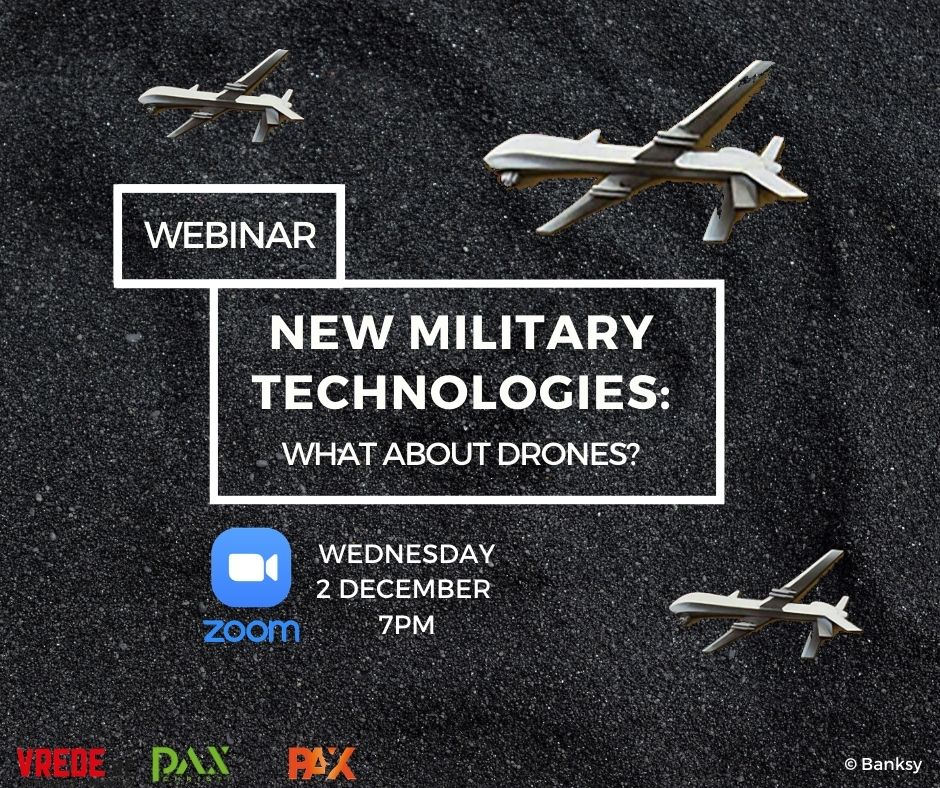Event Summary: New military technologies: What about drones?

As the cases of Yemen, Libya, Northern Syria and the recent events in Nagorno-Karabakh demonstrate, the rapidly growing proliferation and use of drones have serious implications for conflicts all over the world. UN experts also remain concerned about their compliance with international humanitarian law and human rights law standards. In a webinar, hosted on December 2nd 2020 by Vrede, Pax Christi Vlaanderen and Pax Netherlands, experts discussed what risks and challenges could be faced by Belgium when deploying drones or other new military technologies. An important development giving rise to this debate is the acquisition by Belgium of 4 SkyGuardian drones that could possibly be armed.
The participants included Doctoral Researcher at the International Security Cluster, Maaike Verbruggen; Chief of Staff of the Air Component at Belgian Defence, Geert De Decker; professor at the Institute of Philosophy of the Catholic University of Leuven, Lode Lauwaert; and director at GRIP (Groupe de recherche sur la paix et la sécurité) and founding member of OSINTPOL, Yannick Quéau. The webinar was moderated by Merel Selleslach from Pax Christi Vlaanderen.
In her talk, Maaike Verbruggen elaborated on the different types of drones currently used in warfare, ranging from smaller tactical drones, like those used on the battlefield in Ukraine, to the Medium Altitude Long Endurance (MALE) drones, such as those acquired by Belgium, more often used by states against military weaker countries or non-state actors. She also said it is important to clarify whether drones as such are of concern, or their specific use and possible lack of compliance with international law, highlighting the lack of transparency and accountability surrounding US lethal drone strikes during counterterrorism operations. She further noted the difficulties in classifying drones into a specific category, which will have implications for their legal regulation and will only become more complicated as drones will gain more autonomous functions.
Geert De Decker explained how he was involved in Belgian military operations in Libya and Iraq, as a ‘’Red Card holder’’, which refers to the role of determining whether a target is lawful or not. While only 4 drones were used in Libya, this changed drastically in Iraq where the multitude of drones used provided a better picture of what was happening on the ground, which in turn was important for preventing collateral damage. With respect to the Belgian SkyGuardian drones, he explained that if armed, the same mandate, red card holders and rules of engagement would apply as when using F16 planes, in order to avoid civilian casualties.
While not stating to be in favour of armed drone operations per se, Lode Lauwaert highlighted in his presentation that drones also present a number of benefits, mentioning their lower price, their capability of being more precise which would lead to less collateral damage, the lower risk to a country’s own soldiers and a greater chance of victory. He added that any calls to regulate armed drones should therefore be well-argumented. He also challenged the often-used argument that the use of armed drones lowers the threshold for the use of force.
As the last speaker, Yannick Quéau addressed some of the statements made by the other participants. In particular he questioned strongly the notion that drones strikes are more precise, pointing at the high number of civilian deaths resulting from drone operations in the context of the global war on terror. With respect to the categorization of drones, he stressed that drones are mainly a software. He added that this could present serious difficulties, calling software a ‘’blind spot’’ in the context of arms control. He further highlighted that while we so far have observed the use of drones in specific conditions, mainly in the context of counterterrorism campaigns, they may also play an increasing role in domestic law enforcement operations, coastal surveillance or during riots.
In response to a question on the difference between drones and autonomous weapons, Maaike Verbruggen clarified that while there is a clear distinction now, drones are gaining more and more autonomous functions, especially where warfare will become more symmetrical. Here, an increased use of artificial intelligence in drones would not merely manifest itself in targeting, but also in mobility and communications between devices. On drone proliferation, she explained that while the expensive MALE drones like the SkyGuardian are not available to everyone, smaller tactical drones and especially the small commercially available drones can fall more easily in the hands of non-state actors. She also pointed at the rising interest in counter drone technology.
The discussion also touched briefly upon the often-raised concern that drone strikes may generate anger and resentment among the civilian population, which in turn may lead to more violence rather than ending it. Lode Lauwaert did not deem drone strikes in this sense to be different from firing a gun. Yannick Quéau did not agree as drone strikes can reach more remote areas. He added that this is also often a result of a strategic adaptation in the behaviour of terrorist groups who hide among the civilian population knowing that it will increase the chance of civilian casualties.
In relation to the information-gathering capabilities of drones, Geert de Decker clarified that decisions on whether to carry out a military attack would in most cases not be based solely on information gathered by drones. On the sharing of data, he explained that most military operations take place in a coalition where information gathered would be brought to the table and shared with the rest of the coalition members. A red card holder could technically impose limits on this, but he has never seen this happening. He finally added that the arming of the SkyGuardian drones is not foreseen for the near future, but that it will depend on the situation on the ground.
Missed the event? It can be rewatched here.

